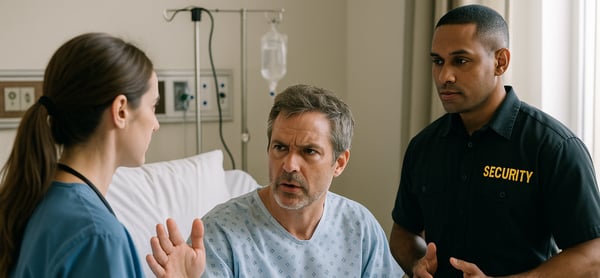In healthcare settings, every interaction carries the potential to either heal or harm. Even a routine medical encounter can quickly transform from a healing opportunity into a re-traumatizing experience. As healthcare professionals, understanding trauma-informed communication isn't just beneficial—it's essential for providing compassionate, effective care that honors the dignity of every...
Posts about Articles (2)
Verbal De-escalation: Essential Skills for Healthcare Professionals
Healthcare environments are high-pressure settings where emotions can run high and tensions can escalate quickly. With 76% of emergency room nurses reporting experiences with workplace violence and The Joint Commission noting a consistent increase in violence-related incidents over the past five years, the ability to prevent escalation when able and de-escalate situations verbally when necessary...
How to Budget for Conflict Prevention (and Why You Can't Afford Not To)
Healthcare organizations methodically budget for equipment, technology, supplies, and facilities. They forecast staffing needs, plan for market changes, and invest in strategic growth. Yet when it comes to conflict prevention, many organizations struggle to establish structured budgeting approaches. Conflict management initiatives often fall into the nebulous category of "soft skills" or...
Why Compliance Training Won't Save Your Reputation
Healthcare organizations invest heavily in regulatory compliance training—from annual workplace violence prevention modules to harassment awareness courses. Administrators track completion rates, verify documentation, and prepare for surveys with meticulously maintained records. When regulators visit, these training programs provide evidence of "reasonable efforts" to address workplace safety...
The ROI of Respect: How Culture Impacts Operational Outcomes
In healthcare's data-driven environment, leaders constantly evaluate return on investment for clinical initiatives, technological implementations, and operational changes. ROI calculations influence everything from capital expenditures to staffing models. Yet when it comes to the culture of respect within an organization, many leaders rely on intuition rather than metrics, assuming that while...
How Much is Conflict Costing You?
Healthcare leaders track countless financial metrics—from length of stay and operating margins to supply costs and reimbursement rates. Yet one of the largest cost drivers in healthcare remains largely unmeasured and unmanaged: workplace conflict.
Surviving Hostage Situations in Healthcare Active Assailant Attacks
Active assailant incidents in healthcare facilities present one of the most extreme challenges for staff, patients, and security professionals. While the primary goal in any such event is always to escape from danger if possible, circumstances may arise where escape is not an option. In these rare but high-risk situations, individuals must rely on a contingency plan that includes barricading,...
When 'Nonviolent' Isn't Enough: Redefining the De-escalation Standard
Healthcare organizations have embraced de-escalation training as a cornerstone of workplace violence prevention. These programs typically aim to prevent physical aggression through verbal and non-verbal techniques that calm agitated individuals. Success is often defined simply: if no one gets hurt, the de-escalation is deemed successful.
Incident Reporting Isn't Enough: What Your Team Isn't Telling You
Healthcare organizations rely heavily on incident reporting systems to identify and address safety concerns, including workplace violence. These systems typically capture serious events like physical assaults, sexual harassment, or explicit threats. Organizations track these reports, analyze trends, and implement targeted interventions based on the resulting data.
But what about all the events...
Verbal Triage: A Necessary Step in Violence Prevention
In healthcare environments where resources are limited and demands are high, triage represents a fundamental organizing principle. Clinical triage sorts patients based on acuity to ensure appropriate resource allocation. Yet when it comes to violence prevention, many healthcare organizations lack a systematic approach to early assessment and intervention. The result is reactive rather than...












